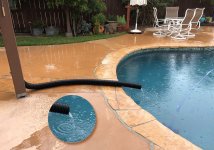- Feb 6, 2015
- 7,807
- Pool Size
- 12300
- Surface
- Plaster
- Chlorine
- Salt Water Generator
- SWG Type
- CircuPool RJ-45 Plus
Try reusing the original PoolMiser valve base as @Dirk and @1poolman1 suggest.OK, that isn't going to work in my Poolmiser sump. Looking at this video you shared in a different thread, it looks like that seal expects to sit inside a riser/boss which does not exist in my Poolmiser sump. I just have a threaded hole in the bottom of the sump to accept the fill valve threads, there's nowhere for me to install this restrictor seal. The Poomiser instructions do not call for any such restrictor seal, either.
I did confirm that turning down the hose spigot to a trickle does solve the issue (confirming that high fill rate is root cause), but that seems to create a bunch of noise in the house so that's not a long term solution.
I think I will have to resort to buying to the Poolmiser specific fill valve, I do notice the bottom of the fill valve is a slightly different design than what I have, so I wonder if this has some form of built-in restriction. The old fill valve also has the slightly different design, which has me thinking that might have been an original Poolmiser part with a Kohler replacement cap on it (instead of being a Kohler part altogether).
Barring that, for the difference in price between the PoolMiser valve and a standard Fluidmaster, I'd fabricate some type of restrictor. Since the valve has to screw into the threaded hole, I suspect a washer would fit that hole as well.
Here is confirmation that the original PoolMiser valve has a pressure reducer built into the lower valve base to reduce/eliminate the water hammer you experienced.

Step-by-step instructions on installing the valve — POOLMISER
Last edited:




